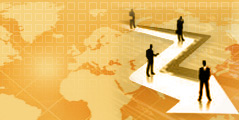Inflation is the overall general upward price movement of goods and services in an economy, usually as measured by the Consumer Price Index and the Producer Price Index. Substantial rise in the general level of prices related to an increase in the volume of money and resulting in the loss of value of currency.
Types of Inflation
There are four main types of inflation. The various types of inflation are briefed below.
Wage Inflation
Wage inflation is also called as demand-pull or excess demand inflation. This type of inflation occurs when total demand for goods and services in an economy exceeds the supply of the same. When the supply is less, the prices of these goods and services would rise, leading to a situation called as demand-pull inflation. This type of inflation affects the market economy adversely during the wartime.
Cost-Push Inflation
Cost Push Inflation, as the name suggests, if there is increase in the cost of production of goods and services, there is likely to be a forceful increase in the prices of finished goods and services. For instance, a rise in the wages of laborers would raise the unit costs of production and this would lead to rise in prices for the related end product. This type of inflation may or may not occur in conjunction with demand-pull inflation.
Pricing Power Inflation
Pricing Power Inflation is more often called as administered price inflation. This type of inflation occurs when the business houses and industries decide to increase the price of their respective goods and services to increase their profit margins. A point noteworthy is pricing power inflation does not occur at the time of financial crises and economic depression, or when there is a downturn in the economy. This type of inflation is also called as oligopolistic inflation because oligopolies have the power of pricing their goods and services.
Sectoral Inflation
This is the fourth major type of inflation. The sectoral inflation takes place when there is an increase in the price of the goods and services produced by a certain sector of industries. For instance, an increase in the cost of crude oil would directly affect all the other sectors, which are directly related to the oil industry. Thus, the ever-increasing price of fuel has become an important issue related to the economy all over the world. Take the example of aviation industry. When the price of oil increases, the ticket fares would also go up. This would lead to a widespread inflation throughout the economy, even though it had originated in one basic sector. If this situation occurs when there is a recession in the economy, there would be layoffs and it would adversely affect the work force and the economy in turn.
|
Year
|
Inflation Rate (Consumer Prices)
|
|
2003
|
3.10 %
|
|
2004
|
3.10 %
|
|
2005
|
5.50 %
|
|
2006
|
7.60%
|
|
2007
|
6.20 %
|
|
2008
|
2.80
|
|
2009
|
9.30 %
|




